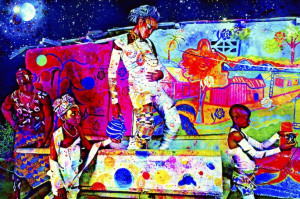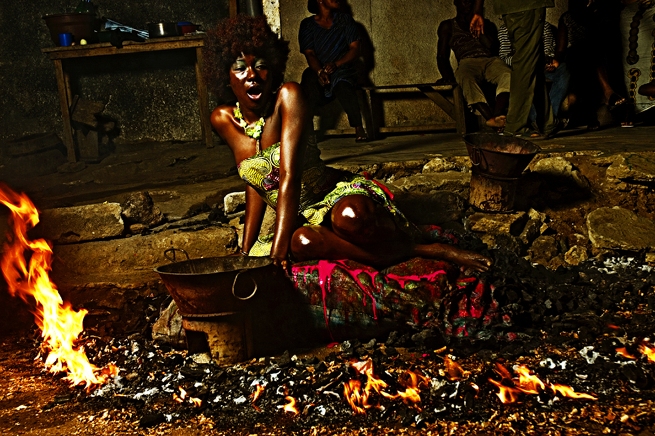
“The colours I use also grab people’s attention: in a busy world where we move fast and are bombarded by visual, audio and other sensory stimuli, they shout at the viewer’s mind, and work to create the fraction of silence in the observer necessary to start the conversation.”
Mami Momi.
About:
Ivorian photographer Paul Sika has birthed his very own style. He calls it ‘photomaking’ and combines digital photography with painterly post-production to produce brightly-coloured, densely textured images teeming with energy and drama. Born in 1985, he travelled to the UK to study Software Engineering, in the hopes of making video games — that was the dream until he had an epiphany while watching the trailer for The Matrix Reloaded. He purchased a camera, began taking photographs and moved back to Abidjan where a burgeoning arts scene always provides inspiration and a cast of young creative people contribute to his photographic practice.
 Gloglo Gospel.
Gloglo Gospel.
In contrast to the established tradition of West African studio photography, Paul Sika’s richly imagined images are dense with highly saturated colour and bodies striking exaggerated poses. His aim is to force the viewer into an unfamiliar headspace, in which a new conversation — quite outside the ordinary — can begin. So when Sika said that he hoped, with his work to give “visions of things to come,” we began to understand just what he meant.
 Marmite Mousso.
Marmite Mousso.
“Influenced by filmmaking, my technical process starts with imagining the story, which I then write down as a script. I break that script down into sequences which eventually become photos. Then I cast models and we rehearse if needed. After that comes principal photography, which produces the digital stills I use in post-production. And finally I apply a layer of digital painting to create the look necessary to effectively tell the story. This process has streamlined over time as I gained more experience.”

Memi Momi
“Colour is an element of my story-telling as important as the shapes of objects and lighting of the scene. It reflects the essence of the story I’m telling and helps foster a certain mood. The colours I use also grab people’s attention: in a busy world where we move fast and are bombarded by visual, audio and other sensory stimuli, they shout at the viewer’s mind, and work to create the fraction of silence in the observer necessary to start the conversation.”
(from interview on OkayAfrica by Derica Shields)
– See more at: http://www.okayafrica.com/news/african-photography-paul-sika-the-africa-photomaker-with-visions-of-things-to-come/#slide1
 Charbon Fire.
Charbon Fire.
Courtesy: Galerie Fakhoury, Abidjan.
